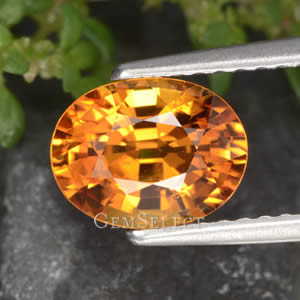Heat Treatment
Centuries ago, someone stumbled upon the magical effect of applying heat to gemstones. High heat, such as that from a charcoal fire, can make a bland looking gemstone change its color into something spectacular. If this fortunate technique was not discovered, there would be very few affordable gemstones of good color on the market.

Heated Orange Sapphire
Heat treatment is considered to be a natural type of enhancement as it is a continuation of the processes that occur in the earth when the stone was originally formed. During treatment, the stone is heated to very high temperatures (approximately 1600 Celsius) causing inclusions, chemical elements, and other impurities to reform themselves and change the color of the stone. This color change may result in the stone being darker, lighter, more intense or of a different color. An example of this is the dissolving of rutile silk inclusions in blue sapphires, which improves both clarity and color. This heat treatment is permanent and irreversible.
Another example is ruby. This is a stone that is commonly heat treated. Only the most valuable and expensive rubies possessing the richest colors are not heat-treated. Ruby is heated almost to its melting point, allowing the aluminum oxide in the stone to reform, creating a new crystal structure. This allows the chromium in the stone to combine with different atoms, allowing for a better red hue. The same can apply to a type of sapphire known as gouda sapphire. These milky white sapphires turn blue, and account for many of the quality sapphires on today's market.
Detection of heat and diffusion treatment is possible because these treatments modify natural inclusions. The destruction of gas or fluid inclusions or the dissolving of mineral inclusions are clues to heat treatment. For gems that contain rutile needles, the needle margins may become diffuse. On rubies, inclusions may be found that are glassy in appearance. These are caused by borax-based substances that are used in the heat treatment process.
It is usually more difficult to find out if a stone has not been treated than if it has. Unadulterated stones can be harder to verify. However, there are some clues that can help. For example, gemologists can examine the inner workings of the stone and study the inclusions for signs of heat treatment. For example, if the stone has been treated, tiny inclusions such as small crystals will melt during the heat treatment process. A gemologist can easily see this using a microscope. An absence of such evidence could suggest an untreated stone.
Centuries ago, men sitting in front of charcoal fires were the first practitioners of the art of heat treatment. They would use pieces of bamboo to blow air into glowing charcoal where a few stones were placed, in an attempt to coax some new colors into their stones. Today, the technology is much more sophisticated, with professionals using large computer controlled electric furnaces. The old, crude methods are gone, but the result is still the same; drab gemstone are turned into something beautiful. This allows us all to have the chance to own a colored gemstone that we can be proud to show.
Amethyst, citrine, ametrine, aquamarine, tourmaline, topaz, light green tourmaline, sapphire, ruby, tanzanite, and blue zircon are gemstones that are typically color-enhanced by heat treatment. Here is a full list of the more commonly heated stones and how heat treatment enhances them.
| • |
Amethyst - lightens the color and will change the color of pale amethyst to "yellow" that will be sold as citrine.
|
| • |
Aquamarine - removes the greenish undertones that are common in this stone to produce a more blue stone. Also deepens the color.
|
| • |
Citrine - often produced by heating varieties of quartz.
|
| • |
Kunzite - to improve color.
|
| • |
Morganite - heat treatment changes the color from orange to pinkish.
|
| • |
Ruby - heat treatment improves color, removes iron stains, dissolves inclusions and fills tiny cracks.
|
| • |
Sapphire - to lighten or intensify color and to improve the uniformity of the color.
|
| • |
Tanzanite - to produce a more desirable blue shade.
|
| • |
Topaz - when used with irradiation, heat treatment will produce shades of blue. Also done to produce a pink topaz.
|
| • |
Tourmaline - to lighten darker shades of tourmaline. This is usually done with the green and blue varieties.
|
| • |
Zircon - to produce red, blue, or colorless stones.
|
|
